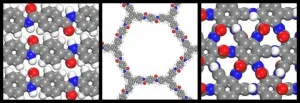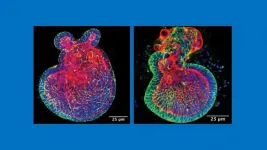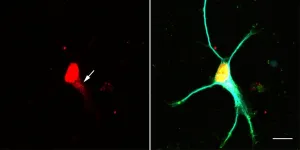(Press-News.org) UNIVERSITY PARK, Pa. -- The optimal timeframe for donating convalescent plasma for use in COVID-19 immunotherapy, which was given emergency use authorization by the Food and Drug Administration in August 2020, is within 60 days of the onset of symptoms, according to a new Penn State-led study. The research also reveals that the ideal convalescent plasma donor is a recovered COVID-19 patient who is older than 30 and whose illness had been severe.
"Millions of individuals worldwide have recovered from COVID-19 and may be eligible for participation in convalescent plasma donor programs," said Vivek Kapur, professor of microbiology and infectious diseases, Penn State. "Our findings enable identification of the most promising donors and suggest that these people should donate quickly before their antibodies begin to wane."
To investigate the duration of the immune response to SARS-CoV-2, the team examined the titers of IgM, IgG and virus neutralizing (VN) antibodies in a cohort of 175 convalescent plasma donors for 142 days after the patients' symptoms began.
"IgMs are the first group of antibodies to appear upon infection," explained Sreenidhi Srinivasan, postdoctoral scholar in the Huck Institutes of the Life Sciences, Penn State. "After about two weeks, the body switches to making IgG antibodies, which are more durable and long-lasting."
VN antibodies are those IgM and IgG antibodies that bind directly to viruses and prevent them from infiltrating cells, added Abhinay Gontu, graduate student in pathobiology, Penn State. "The levels of these VN antibodies are, by far, the best possible metric for choosing potential donors for immunotherapy provides because they provide the most protective immunity," he said.
Unfortunately, added Kapur, VN antibodies have been difficult to detect with current antibody tests. However, in a recent paper published in the Journal of Clinical Investigation, the team reported the results of its study showing that VN titers are correlated with certain types of IgG antibodies, and that ELISA assays, or enzyme-linked immunosorbent assays, can be used to determine the titers of these IgG antibodies faster and easier than currently used methods.
In their current study -- which published on February 24 in Communications Biology, a sub-journal of Nature -- the researchers used ELISA assays to determine the longevity of IgM, IgG and VN antibodies in their study participants. They found that robust IgM and IgG antibodies persisted in their study participants for at least 140 days after the onset of COVID-19 symptoms; yet, VN antibodies declined rapidly after 60 days to below the FDA's recommended level for convalescent plasma donation.
"Our finding that a strong immune response persists through 140 days after symptom onset in most COVID patients was unexpected and is contrary to the claims of short-lived immunity and potential re-infection of some COVID patients," said Suresh Kuchipudi, clinical professor of veterinary and biomedical sciences, Penn State.
Kuchipudi noted that in their previous study, he and his colleagues found that nearly 40% of the donors they studied lacked the necessary VN antibodies to pass on immunity to others, likely because their window of opportunity for donation had passed.
"This is particularly important when you consider that, to date, more than 100,000 COVID-19-infected individuals in the United States have received convalescent plasma donations from recovered patients," he said.
Kapur added, "Taken together, our findings suggest that care should be taken in identifying which recovered patients qualify to be donors and that, if they choose to donate, these donors should do so quickly before their valuable VN antibodies begin to wane."
INFORMATION:
Other authors on the paper include Meera Surendran Nair, Ruth H. Nissly, Denver Greenawalt, Ian M. Bird, Catherine Herzog, Matthew J. Ferrari, Indira Poojary, Robab Katani, Scott E. Lindner, Allen M. Minns and Randall Rossi, all at Penn State. Authors from the Houston Methodist Hospital include Eric Salazar, Paul A. Christensen, Brian Castillo, Jian Chen, Todd N. Eagar, Xin Yi, Randall J. Olsen, Picheng Zhao, Christopher Leveque, David W. Bernard, Jimmy Gollihar and James M. Musser. Todd N. Eagar, Xin Yi, Randall J. Olsen, David W. Bernard and James M. Musser are also affiliated with the Weill Cornell Medical College. Jimmy Gollihar is also affiliated with the CCDC Army Research Laboratory-South.
The National Institute of Allergy and Infectious Diseases, Army Research Office and Huck Institutes of the Life Sciences at Penn State supported this research.
CHAMPAIGN, Ill. --Many climate models focus on scenarios decades into the future, making their outcomes seem unreliable and problematic for decision-making in the immediate future. In a proactive move, researchers are using short-term forecasts to stress the urgency of drought risk in the United States and inform policymakers' actions now.
A new study led by University of Illinois Urbana-Champaign civil and environmental engineering professor Ximing Cai examines how drought propagates through climate, hydrological, ecological and social systems throughout different U.S. regions. The results are published in the journal Geophysical Research Letters.
"The same amount of precipitation, or the lack of thereof, in one region could have very different impacts on the hydrologic ...
Black men and women, as well as adolescent boys and girls, may react differently to perceived racial discrimination, with Black women and girls engaging in more exercise and better eating habits than Black men and boys when faced with discrimination, according to research published by the American Psychological Association.
"In this study, Black women and girls didn't just survive in the face of racism, they actually responded in a positive manner, in terms of their health behavior," said lead researcher Frederick Gibbons, PhD, with the University of Connecticut. "This gives us some hope that despite the spike in racism across the country, some people are finding healthy ways to cope." ...
ADELPHI, Md. -- Army researchers reached a breakthrough in the nascent science of two-dimensional polymers thanks to a collaborative program that enlists the help of lead scientists and engineers across academia known as joint faculty appointments.
Researchers from the U.S. Army Combat Capabilities Development Command, now known as DEVCOM, Army Research Laboratory partnered with Prof. Steve Lustig, a joint faculty appointment at Northeastern University, to accelerate the development of 2D polymers for military applications.
The collaboration with ARL Northeast led to a groundbreaking study published in the peer-reviewed scientific journal Macromolecules. Editors featured the research in a cover article.
"2D polymers have been studied very seriously from a synthetic ...
Researchers have developed a tool to identify security and privacy risks associated with Covid-19 contact tracing apps.
COVIDGuardian, the first automated security and privacy assessment tool, tests contact tracing apps for potential threats such as malware, embedded trackers and private information leakage.
Using the COVIDGuardian tool, cybersecurity experts assessed 40 Covid-19 contact tracing apps that have been employed worldwide for potential privacy and security threats. Their findings include that:
72.5 per cent of the apps use at least one insecure cryptographic ...
Medical researchers have long understood that a pregnant mother's diet has a profound impact on her developing fetus's immune system and that babies -- especially those born prematurely -- who are fed breast milk have a more robust ability to fight disease, suggesting that even after childbirth, a mother's diet matters. However, the biological mechanisms underlying these connections have remained unclear.
Now, in a study published Feb. 15, 2021, in the journal Nature Communications, a Johns Hopkins Medicine research team reports that pregnant mice fed a diet rich in a molecule found abundantly in cruciferous vegetables -- such as broccoli, Brussels sprouts and cauliflower -- gave birth to pups with stronger protection against necrotizing enterocolitis (NEC). ...
Neurodegenerative diseases, such as various forms of senile dementia or amyotrophic lateral sclerosis (ALS), have one thing in common: large amounts of certain RNA-protein complexes (snRNPs) are produced and deposited in the nerve cells of those affected - and this hinders the function of the cells. The overproduction is possibly caused by a malfunction in the assembly of the protein complexes.
How the production of these protein complexes is regulated was unknown until now. Researchers from Martinsried and Würzburg in Bavaria, Germany, have solved the puzzle and now report on it in the open access journal Nature Communications. They describe in detail a signaling pathway that prevents the overproduction of snRNPs when they are not needed. The results should ...
A diet rich in human food may be wreaking havoc on the health of urban coyotes, according to a new study by University of Alberta biologists.
The research team from the Faculty of Science examined the stomach contents, gut microbiome and overall health of nearly 100 coyotes in Edmonton's capital region. Their results also show coyotes that consume more human food have more human-like gut bacteria--with potential impact on their nutrition, immune function and, based on similar findings in dogs, even behaviour.
"If eating human food disturbs the 'natural' coyote gut bacteria, it is possible that eating human food has the potential to affect all ...
The answer to the age-old mystery of the evolutionary origins of vertebrate eyes may lie in hagfish, according to a new study by biologists at the University of Alberta.
"Hagfish eyes can help us understand the origins of human vision by expanding our understanding of the early steps in vertebrate eye evolution," explained lead author Emily Dong, who conducted the research during her graduate studies with Ted Allison, a professor in the Faculty of Science and member of the U of A's Neuroscience and Mental Health Institute. "Our findings solidify the hagfish's place among vertebrates and open the door to further research to uncover the finer details ...
Blocking seizures after a head injury could slow or prevent the onset of dementia, according to new research by University of Alberta biologists.
"Traumatic brain injury is a major risk factor for dementia, but the reason this is the case has remained mysterious," said Ted Allison, co-author and professor in the Department of Biological Sciences in the Faculty of Science. "Through this research, we have discovered one important way they are linked--namely, post-injury seizures."
"There is currently no treatment for the long-term effects of traumatic brain injury, which includes developing dementia," added lead author Hadeel Alyenbaawi, who recently completed her PhD dissertation on this topic in the Department of Medical Genetics in the Faculty ...
INFORMS Journal Management Science Study Key Takeaways:
Changing an employee's hours during their shift, typically by having them stay longer, hurts restaurant revenue.
Checks for parties handled by servers who'd been asked to stay longer during their shift dropped by 4.4%, on average.
Servers asked to stay longer reduced the effort spent on upselling and cross-selling additional menu items.
CATONSVILLE, MD, February 25, 2021 - Short notice versus no advance notice makes a huge difference when it comes to employee scheduling in the restaurant industry. New research in the INFORMS journal Management Science finds checks for parties handled by servers who were asked (with ...





